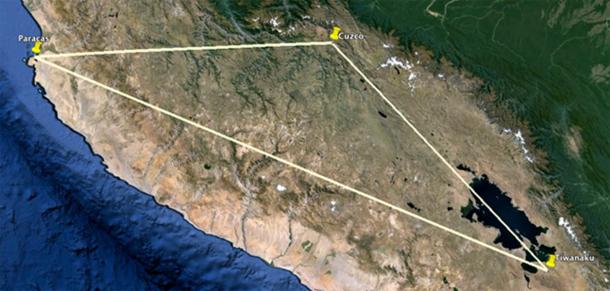Guest
Guest
 |  Subject: Ancient Sacred Sites Triangularly Aligned by the Footsteps of the Gods Subject: Ancient Sacred Sites Triangularly Aligned by the Footsteps of the Gods  Sat Jun 18, 2016 6:53 am Sat Jun 18, 2016 6:53 am | |
|  17 JUNE, 2016 - 14:48 FREDDY SILVA 17 JUNE, 2016 - 14:48 FREDDY SILVA
Ancient Sacred Sites Triangularly Aligned by the Footsteps of the Gods
(Read the article on one page)
Ancient architects not only placed temples sharing commonalities according to perfect triangles, they did so from the sky and across vast distances.
 
The Hindu Trimurti is the eastern equivalent of the Holy Trinity, in which the gods Vishnu, Brahma and Siva represent the three faces of the central godhead. In the Rig Veda there exist numerous accounts of Vishnu's unusual behaviour of "measuring out the Earthly regions, thrice setting down his footstep."
The Hindu Trimurti: Vishnu, Brahma and Shiva seated on their respective mounts. ( Public Domain )
Given that sacred texts and myths are marvellous containers for great concepts, and that so many ancient sacred sites are said to be the manifestations of the energy of gods, is it possible that temples and other sacred places were once placed according to the geometric representation of the trinity: the triangle?Three Mountain ShrinesThe advent of satellite imagery now makes it possible to accurately prove such grand concepts, although the angles themselves are measured at ground level. Take the three mountain shrines throughout the Indian subcontinent specifically associated as abodes of Siva (an aspect of Vishnu) — Mount Kailas, Maa Sharda and Gabbar — which also double as repositories of the knowledge of the gods or their superabundant energy. The three form a perfect right-angle triangle covering over 1600 miles (2575 km).The Kailas-Maa Sharda-Gabbar trinity.
The same plays out in China, with the three holiest mountains in Taoist faith — T'ai Shan, Heng Shan and Hua Shan — all believed to be repositories of a cosmic force, all associated with the Otherworld and renewal of the soul, all used since Paleolithic times: all connected by an isosceles triangle, centered on their respective man-made shrines.
- The Sacred Three in Asian Beliefs: Triple Gods, Tridevi, and the Three Treasures
- Mathematical Encoding in the Great Pyramid
- The Weird Wolds of Yorkshire: Inside the Mysterious Wold Newton Triangle
Skeptics will quickly point out that any features can be chosen at random to create fictitious alignments. Perhaps. But when the chosen sites all share a number of commonalities, it lowers the odds of chance and raises the probability that such geodetic precision was deliberate. If the pattern is repeated elsewhere, the odds of chance dwindle considerably.The Three PillarsConsider the following Andean sites. Tiwanaku ('the navel at the center') is a megalithic complex built by the god Viracocha and seven Shining Ones following a global catastrophe that wiped out most of the Earth. One of Tiwanaku's oldest components is the semi-subterranean temple, where stand three pillars that are reminiscent of a massive geoglyph, carved onto a hillside 500 miles (804 km) away in Paracas, which depicts three flaming uprights forming a 'Tree of Knowledge'; local folklore suggests Paracas was the landing place of the aforementioned gods. The same story appears in a third location, Cuzco (also a ‘navel of the earth’), where Viracocha traveled to after building Tiwanaku, and where the knowledge of said gods was deposited. Three sites sharing identical purpose, myth, and possibly, age, form a perfect isosceles triangle, Tiwanaku and Paracas being equidistant from Cuzco. The path connecting them stretches over 1100 miles (1770 km).
Tiwanaku, Cuzco and Paracas, places associated with the knowledge of the gods, form an isosceles triangle.
Cuzco itself forms a trinity with two local sites, Saqsayhuaman and Q'uenqo. The three once formed part of a procession associated with an initiation ritual where candidates entered the Otherworld and returned enlightened. Despite the two latter temples being located out of sight on the steep hill above the city, the three are nevertheless connected with absolute precision by an isosceles triangle. Interestingly, the actual point on Saqsayhuaman is a megalithic, horseshoe shaped enclosure that neatly holds the imaginary line from Cuzco.The navel of Cuzco, the horseshoe of Saqsayhuaman and the ritual chamber of Q'uenqo form an isosceles triangle.
Viracocha and his seven colleagues are an echo of the Egyptian Aku Shemsu Hor, literally ‘Shining Ones, Followers of Horus’. Egyptian texts describe them as survivors of a catastrophic global flood, after "seven burning mountains destroyed the Earth."A depiction of Viracocha ( Public Domain )
These gods were entrusted with “resurrecting the former world of the gods,” which they undertook by rebuilding sacred sites along the Nile, starting at On, and then extending their work abroad. The temples they built are mirror images of the perfection of the heavens, and since the sky was the abode of gods — which in ancient times were interchangeable with the forces of nature — it stood to reason that the ancient sacred sites were also be living images of the gods themselves. |
|





